Hartheim castle (near
Linz in Austria) was built
at the end of the 16th century. By
1793 the building belonged to
the princes of
Starhemberg. In
1898 Hartheim castle was donated to the
Landes wohltätigkeitsverein in Oberösterreich
(Provincial Charity Club of Upper Austria), in order to install a
home for physically and mentally handicapped children.
During Nazi Germany's affiliation of Austria, the building was
expropriated. In
1939 the castle was converted into a
Aktion T4
euthanasia centre with
gas chamber and crematorium.
At the western side of the castle a wooden annex was built,
in which the victims left the busses, unnoticed by others.
During
May 1940
the first 633 patients were gassed. Four drivers (among them
Franz Mayrhuber
and
Franz Hödl) drove
the large grey buses of the
Gekrat organisation which carried the victims to the castle, where
they disappeared into a wooden annex. After they have been gassed
("Burner":
Barbel, Bolender, Mertha, Nohel and Vallasta),
gold teeth were extracted from the corpses. After cremation, bones
were still visible among the ashes. These were pulverized to dust
with a bone mill. At least once a week a lorry left the castle and
drove to the rivers Donau and Traun to scatter the ashes into the
water.
Until
August 1941 the death toll of the Hartheim killing center had
risen to 18,269 and later, during the
Sonderbehandlung 14f13
operation, nearly 12,000 victims were killed. Also more than 8,000
inmates of the concentration camps
Dachau and
Mauthausen / Gusen were killed.
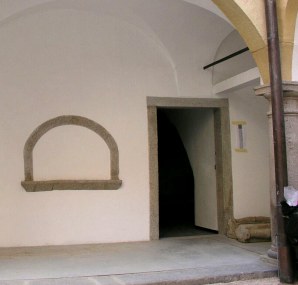 |
| In 2003 |
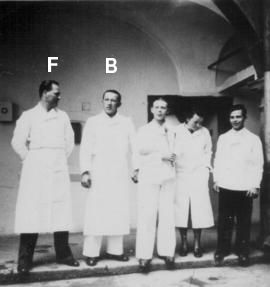 |
| Franz (F) and Bredow (B) in Hartheim |
During the
summer of 1943 Hartheim became a department of
Aktion
T4, since
Berlin was no longer considered to be safe.
Another department was installed at the
Aktion T4
recreation facility "
Haus Schoberstein" in
Weissenbach, at the
Attersee lake in Austria. The population near Hartheim castle
became aware of the killings. Always, after the arrival of a grey
bus, a dark cloud appeared from an invisible chimney. On days with
low cloudbanks, the smoke spread over Hartheim town. It smelled of
burned flesh and hair, causing the townsfolk to be physically sick.
The fact that a lot of people were brought to the castle, but
nobody left it, caused rumours to be spread. To calm down the
citizens, the Hartheim authorities arranged information meetings.
The townsfolk were told that used oil had been burned. A warning
was issued against persons divulging any observations.
During December 1944 and January 1945 inmates of the
Mauthausen
concentration camp had to dismantle and remove the gassing
installations. Most of the documents were destroyed.
After the liberation by General
Patton's Third US Army, the War
Crimes Investigating Team No.6824, headed by Major
Charles Dameron,
found a box which included documents concerning the
Aktion
T4. In these documents so-called "savings" were listed,
documenting the killings. Above 70,000 victims of
Aktion T4
"saved" Germany more than 885,000,000
Reichsmark (today
approximately 3 Billion US$).
In
1954 the rooms of the castle were converted into rental flats.
A number of
Aktion Reinhard personnel served at Hartheim,
these include
Heinrich Barbl, Rudolf Beckmann (perhaps), Kurt
Bolender, Paul Bredow, Helmut Fischer,
Kurt Franz *,
Anton Getzinger, Hans Girtzig, Hubert Gomerski, Karl Gringers,
Ferdinand Grömer, Paul Groth, Gottlieb Hering, Fritz Hirche,
Franz Hödl, Erwin Lambert, Hermann Michel,
Wenzel Rehwald, Franz Reichleitner, Karl Richter, Paul Rost,
Ernst Schemmel, Franz Stangl, Karl Steubl, Friedrich Tauscher,
Josef Vallasta, Gustav Franz Wagner, Arthur Walther and Christian Wirth.
In
1969 a
memorial
was installed in the area used as killing facilities. The
"
Verein Schloss Hartheim" was founded in
1995,
with the objective to reslove the
history of the NS-euthanasia at Hartheim, and to find an adequate
use for the castle.
* See the Franz Photo Story!
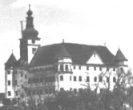
|
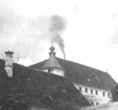
|
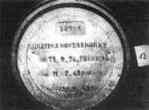
|
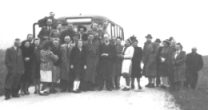 |
| Hartheim |
Trail of Smoke |
Urn |
Crew Excursion |
Learn more about the history of
Katharina Wohlgenannt
who perished in Hartheim.
Source:
Hartheim Memorial
Walter Kohl: "Ich fühle mich nicht schuldig". Wien, 2000
© ARC 2005















